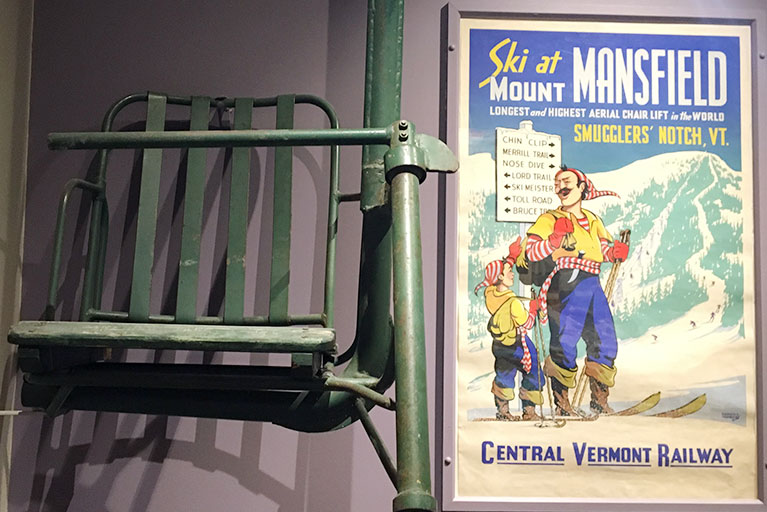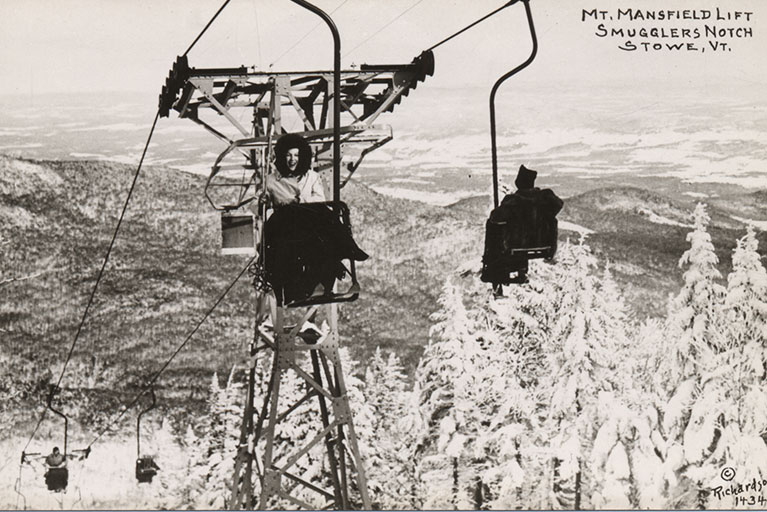Selling Vermont
In the years after World War II, Vermont transformed the way it sold itself to outsiders. That shift in identity made Vermont a four-season state for travelers. It also changed the state’s landscape.
This Episode’s Featured Object:
“Mountainman” Single Chairlift
Amanda Gustin: You just don’t see single chairs anymore, for a lot of reasons. One, I think they’re terrifying. It just looks kind of flimsy to be sitting in that, that high up for that long time. But more practically speaking, skiing is about volume, right?
Mary Rostad: That’s not a very efficient way to transport people.
Amanda: One at a time just takes forever. We have a note here that says when this lift was put in, it took 15 minutes to get to the top of the mountain. Fifteen solid minutes to get to the top of the mountain. So it wasn’t moving terribly quickly.
Members of the 10th Mountain Division during training at Camp Hale, Colorado.
A skier on the single chair lift on Mt. Mansfield.
Romaine Tenney (left) and James Wu (right), an official from the interstate project, talk on the Tenney farm. Photograph from the Vermont Agency of Transportation, courtesy of the Landscape Change Program at the University of Vermont.
Browse “269 Best Vermont Life covers” (Pinterest).
Browse photos of the construction of I-89 and I-91 in Vermont (University of Vermont Landscape Change Program.)
Background for Living
This Vermont Development Commission promotional film depicts a family who is interested in buying a home in Vermont. The local realtor and the visiting family explore Vermont’s summer camps, fishing opportunities, horseback riding, skiing, and foliage tours, and make a visit to see Norman Rockwell. Town meeting is cited as a measure of a good place to live.
Episode Transcript
It’s 1940. You’re standing at the base of Mount Mansfield, the tallest peak in Vermont, at what’s now the Stowe Mountain Resort. It’s winter. You’ve got two wooden skis strapped to your feet. How do you get to the top?
Amanda Gustin: What we’re looking at here: it’s a single chair and it’s not even a very big chair. The lift itself is metal, it’s just the one bar, we’ve actually got it attached to the ceiling here in the exhibit. The actual seat of this chairlift is just wood.
There is a bar that comes across your lap but it’s just a bar. It would have swung out along with the foot bar. The foot bar is covered in, maybe looks like a vinyl.
Mary Rogstad: Yeah. Something painted green, like a vinyl fabric.
If you ride up this same mountain today, you’ll probably take a quad – a sturdy chairlift that holds four people. Or maybe you’ll pack eight of your companions into a fully enclosed gondola. These single chair ski lifts held parties of one.
Episode Credits
Before Your Time is presented by the Vermont Historical Society, the Vermont Humanities Council, and VTDigger. Our show was produced by Mike Dougherty, Eileen Corcoran, Amanda Gustin, and Ryan Newswanger, with help from Mary Rogstad. Thanks to our guests Brian Lindner, Thelma Osgood, and Tom Slayton. Film clips were from a tourism film called “Background for Living.”
Music by Michael Chapman and the Woodpiles, Blue Dot Sessions, and Uuriter.



